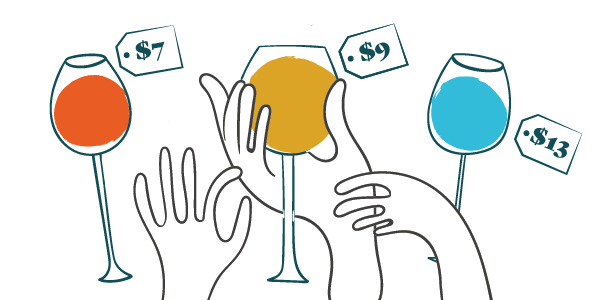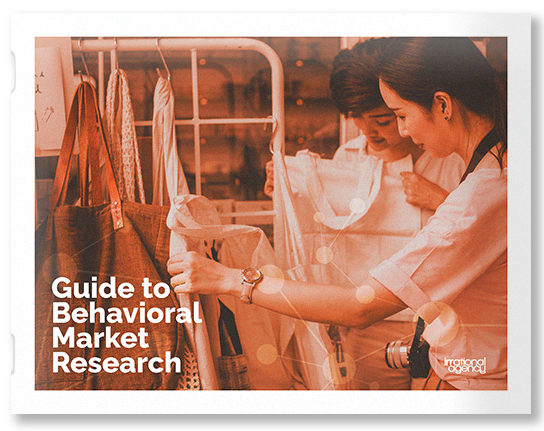
Mind Reading: What You Always Wanted to Know But Didn't Know How to Ask Your Customer
 Irrational Agency
Irrational Agency
Business would be much simpler if we could read customers’ minds. Despite advances in neuroscience, technology might not quite have reached that point yet. But directly asking customers for those thoughts doesn’t work either. Nobody is fully aware of the powerful processes and subtle nuances happening in their own mind. The human brain goes through dozens of complex, invisible tasks to navigate just one buying decision.
For example, when you ask a consumer why they bought a washing detergent, they might offer their reasoning as “It cleans better.” But the reality may be that a marketing message or even a subtle pricing strategy created that unfounded thought in the consumer’s brain, and they simply acted on it, taking it as fact.
If asking a customer for the reasoning behind their decision is not the best approach, how can brands ever gain clarity about the consumer experience? If a simple survey cannot capture the complexity of consumer behavior, then what can? Is there a way to better uncover the decision-making framework created by the human brain?
The best practice is to consider HOW we ask the questions before we ask the questions. Let us explain:
Thinking about Thinking
The first step to consider when you think about the subtle layers of decision-making is the non-conscious. Non-conscious decisions occur as, in reality, customers are often unaware of what drives their behavior.
EXAMPLE: A customer self-reports their desire to buy more sustainable products. Research shows they often override this conscious choice with non-conscious inputs that lead them to, time and time again, choose the more familiar brand or product regardless of its sustainability practices. Uncovering specifics of how these thinking pathways diverge in real-time is the key to understanding what narratives drive this inconsistency.
Non-conscious drivers need to be measured and understood. Simple surveys fall short because they ask questions of the conscious mind, about decisions that are largely directed by the non-conscious mind. It’s not about asking the right questions at all. Instead, we need to think about how humans think. Use tools that acknowledge and reveal the complexity of the human decision-making process. To realize that thinking is not a logical two-step process is the beginning of getting meaningful insights about consumers’ opinions and experiences.
Understanding the Non-Conscious Drivers
Behavioral science has been a leading force in understanding non-conscious drivers and how they impact the decision-making process. Behavioral science (sometimes referred to as behavioral economics) is the study of human actions. As a practical market research tool, it links cognitive neuroscience with economics, illuminating the hidden narratives, powered by personal beliefs, that drive those human actions.
Behavioral economics tells us that when buying a product, people always try to simplify the process. For example, going with the default or a known entity when deciding between different products of similar quality and design. Consider how often you find yourself making decisions on auto-pilot without evaluating an alternative solution that might better meet your needs? Consider how many purchases are habit-based.
As consumers, we all use these mental shortcuts to help our brains deal with the heavy workload of decisions we make every second. Understanding this default mode, businesses can take measures to create circumstances that will promote the products they wish the consumer to purchase.
Starting with this fundamental understanding of how powerful the non-conscious mind is, we can then apply brain science to a brand’s advantage. From here we can formulate better questions or even create an environment to have a conversation with consumers that help brands uncover deeper truths and clear away the knee-jerk reactive answers. Understanding the dance between conscious and non-conscious drivers allows researchers to better navigate the landscape of a buyer’s mindset and formulate questions to uncover new insights.
Narrative Research
Recent discoveries in behavioral science go beyond these simple insights of defaults and habits, with the emergence of narrative research. Inner narratives are deeply personal scripts that our brains run consciously and unconsciously in layered loops. Research has shown that powerful internal narratives are directing non-conscious and conscious decisions, alike, in the human brain.
EXAMPLE #1: A product as simple as hand soap is very difficult to differentiate through functionality. Now, imagine the scent of the soap your grandparents used to buy. You can’t help but remember the feelings of safety and love from your best moments with them. That memory is a story more powerful than any packaging claim. If asked, few consumers would offer this as the reason for their purchase and even fewer would be aware this informed the decision.
Neuroscience is developing as a tool to show the deep power of the stories we tell ourselves that fuel our behavior. Ironically, traditional market research strips away this valuable context and narrows things down into very simplified explanations that no longer have meaning.
EXAMPLE #2: How likely are you to recommend this company to a friend or colleague?

On a scale of 1 to 10, is there a difference between a four and a five? Is it all that meaningful when considering consumer sentiments regarding your brand or product?
To understand what your consumer is thinking, the question, formulated in a logical and numerical fashion, does little to provide insight. Instead of knowing that a customer would rate their likelihood of recommending a product as a “3” or a “6”, insight into the deep reasoning and motivation behind the recommendation would be of greater value to the brand.
A more effective way to do this is to ask, Tell us 5 words you associate with this brand. By analyzing both the meaning and neural reward of the words, a score can still be calculated but backed up with a rich collection of meanings behind the rating.
Narrative research provides context from which the decision was made. This context gives consumer behavior analysis and metrics meaning and supplies the information and insights needed for business impact. The stories that customers tell, along with the data mined from those stories, reveal consumer behavior trends and clues about nonconscious drivers.
Listening to the Stories
Traditional qualitative research draws a clear line between participant and researcher. But delving into people’s stories requires building rapport which is based on an authentically open dynamic. In a behavioral-science-based interview, when we ask others to open up to us, we must also be willing to open up to the participants too. Sharing our stories or the unconscious narratives we have come to understand as a part of our way of seeing the world, invites conversation and genuine sharing. Narrative research uncovers the stories people tell by starting conversations with other story prompts.
EXAMPLE: When trying to uncover non-conscious drivers around sustainability, I might start with a story about how I feel about protecting the earth for my own children. Another story could be centered around the amount of excess packaging used to make food convenient for busy moms. These prompts may invite a mom to share her story about how she evaluates products on the shelf and whether or not ideals, such as sustainability, win in the face of lower price or convenience packaging.
Larger stories may be told about the lack of correct information about sustainable practices. Or perhaps the notion of sustainability, while important to the brand, never figures into the mom’s reasoning when making a purchase. Instead of asking for rote answers on a scale, narrative researchers immerse ourselves in the stories behind the actions - and listen. Whatever the story, letting research participants be the protagonists creates a more personal and intimate view of the decision-making process around the topic being explored.
With decisions often being based on feelings and other constraints, we can take these stories, which are often singular and unique, and uncover larger insights and a better context around complex themes.
Shifting the Blame
A great example of what stories reveal is the tension of responsibility. Using the previous example of sustainability, now that same mom may reframe the same inputs. While one mom may be trying to choose the most sustainable product, another mom may consider the responsibility to furnish only sustainable options to rest on the brand itself or on the retailer:
- Is it the responsibility of every mother to evaluate each purchase, from baby wipes to juice, for the highest sustainability promises?
- Is it the job of the supermarket chain to vet food manufacturers and only provide sustainable options to its guests?
- Is it the job of the manufacturer to choose more sustainable processes and packaging even if it results in higher costs and potentially lower revenue?
These nuances show up in consumer stories and reveal the tensions the human brain has to resolve in each decision. The reality is: there is a limited number of baby wipe options on the shelf. This constraint, in itself, results in a behavioral “heuristic” where the typical consumer will unconsciously default to the “middle of the road” option.
EXAMPLE: Consider your choice at a restaurant from a wine list featuring two wines offered at $7 and $9 per glass. Research has shown us that if a third glass, priced at $13, is inserted into the choice, consumers will consistently pick the $9 glass of wine. As noted in The Psychology of Price by Leigh Caldwell, manufactured constraints give the brain an "easy out" in making a decision that guides them easily to the middle option.

Decision-making is anything but rational. It is often irrational because it is a series of constraints, feelings, and non-conscious drivers. Businesses must make sense of contradictory information and insights. Navigating those contradictions by applying behavioral science tools can provide clear guidance for pricing and communications strategy to successfully promote products and services in a very competitive marketplace.
Qualitative Insights at Quantitative Scale
While each story is personal and unique, behavioral scientists use technology to merge them with thousands of others, allowing patterns and statistical significance to emerge. Singular stories are merged into a collective narrative that helps brands uncover the true drivers behind consumer behavior. Sophisticated AI analysis tools can quickly weigh multiple factors to understand the relationship between and the importance of each element within a narrative study. The mathematical outcome is a much clearer understanding of what is in the mind of the consumer.
So, can I read your mind? I might not be able to guess which playing card you are thinking of right now! But when it comes to understanding the drivers of demand, concept or packaging testing, feature importance, and many other market research needs, narrative research reveals the hidden, non-conscious truth behind consumer decisions.
Get ahead of the curve and take a look at our extensive 30-page guide to behavioral market research. Click to download.

